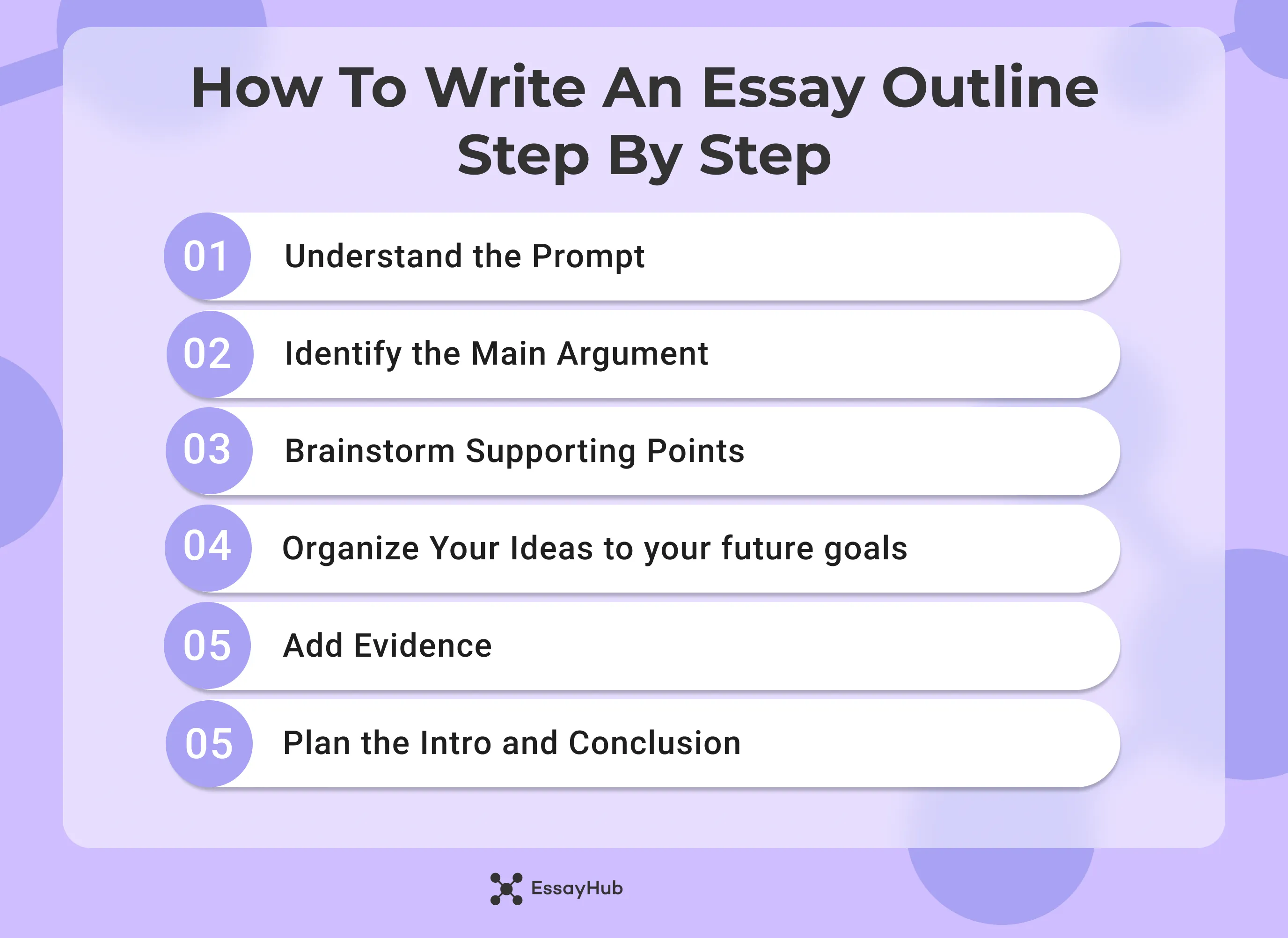Every solid essay has one thing in common: a plan. That plan is called an outline. An essay outline is what helps you figure out which idea goes where and how to keep your writing on track. Instead of trying to put your ideas together, you already have a clear structure you will follow.
This article will walk you through the entire process of writing an essay outline for any type of paper. Once you know the basics, EssayHub's essay writing services are here to help you polish everything to the final stage!
What Is an Essay Outline?
An essay outline is a simple plan you create before you start writing. It lays out the points your essay will cover and how they will be arranged. You're just putting your thoughts into logical order so you don't have to write while guessing what goes where.
The outline stays the same regardless of the essay formats. You’ve got an introduction at the start, body paragraphs in the middle, and a conclusion at the end. Each part includes the points you want to make and the proof you’ll use to back them up.
Parts of an Essay Outline
Most essay outlines stick to the same layout regardless of the type. The next section will talk about the basic parts.
Introduction
The introduction should give the reader a reason to keep going straight away. This part should include:
- A hook to grab attention
- Background information on the topic
- Your thesis statement
It helps to be specific even in the outlining stage. The thesis statement must be clear from the start so it's easier to plan the rest.
Body Paragraphs
You start defending your main points in the body paragraphs. Each should cover a single idea supported by concrete evidence. It also helps to add subpoints under each main point so you don't miss anything. Each paragraph should include:
- The main idea or topic sentence
- Arguments and evidence
- Connection to your thesis
Conclusion
The conclusion ties everything together. This section should leave the reader with something to think about. A strong conclusion must give your essay that complete feel. Include:
- A restatement of your thesis in different words
- A quick summary of the key points you made
- A final insight or closing thought
Writing an Essay Outline Step-by-Step
Now, you can fill in the blanks with your ideas. These steps will help you create a map that's actually easy to follow.

Step 1: Read the Prompt Carefully
Understand what exactly is required of you by reading the prompt carefully. Take notice of any keywords that may indicate the kind of essay you are expected to write. Also, take note of any details on the word count or how you are supposed to format your essay.
Step 2: Identify Your Main Argument
Think about the one idea that you wish to communicate. This will be the central point that will later develop into your thesis statement. The rest of your work will begin to fall into place soon after.
Step 3: Brainstorm Supporting Points
Put the ideas on paper. Write any point or evidence that comes to mind in support of your main point. Your goal at this stage is to get your ideas out so that you can start making sense of them.
Step 4: Organize Your Ideas Logically
Begin piecing the ideas together. Determine which one will be the best to begin with and which points connect to each other naturally. Find the ideas that require a little background to be fully understood and make sure you give the reader enough context.
Step 5: Add Evidence or Examples
Think about the evidence you'll be using. Each fact or evidence must go under the respective paragraphs. You should still know these details even though it's not necessary to have everything fully developed at this point.
Step 6: Plan Your Introduction and Conclusion
Your introduction must catch the reader's attention; the conclusion should leave them something to think about. You should decide how you'd like to begin and end your essay at this stage. Pro tip: Once you move on to writing the entire essay, leave these two parts for the last. It's easier to write the opening and closing once the body paragraphs are fully developed.
Essay Outline Structure
The structure of your essay outline depends on your topic and the type of essay you're writing, but most follow the same basic pattern:
I. Introduction
– Hook or opening idea
– Brief background or context
– Thesis statement
II. Body Paragraph 1
– Topic sentence
– Supporting evidence or example
– Explanation or analysis
– Link to thesis
III. Body Paragraph 2
– Topic sentence
– Supporting evidence or example
– Explanation or analysis
– Link to thesis
IV. Body Paragraph 3
– Topic sentence
– Supporting evidence or example
– Explanation or analysis
– Link to thesis
V. Conclusion
– Restate thesis in fresh words
– Summarize main points
– Closing thought or final insight
Essay Outline Examples
Below are samples for four common types of essays. Each one gives you basic details you can adapt to your own topic.
Argumentative Essay
Topic: Should college education be free?
I. Introduction
– Hook: Student debt is forcing young adults into long-term financial stress.
– Background: Brief overview of rising tuition costs and concerns about accessibility
– Thesis: College education should be free because it promotes equal opportunities
II. Body Paragraph 1 – Equal Opportunity
– Topic sentence
– Statistics on education access
– Examples of income inequality
– Connection to thesis
III. Body Paragraph 2 – Economic Impact
– Topic sentence
– Evidence on workforce development
– Expert quotes or data
– Explanation of benefits
IV. Body Paragraph 3 – National Growth
– Topic sentence
– Case studies from countries with free college
– Potential outcomes in the U.S.
V. Conclusion
– Restate thesis
– Summarize key points
– Final thought on investing in future generations
Persuasive Essay
Topic: Why every student should learn a second language
I. Introduction
– Hook: Learning a second language changes the way your brain works.
– Background info
– Thesis: Schools should require second language learning because it improves cognitive development and improves career prospects.
II. Body Paragraph 1 – Cognitive Benefits
– Topic sentence
– Studies on memory and multitasking
– Real-life examples
III. Body Paragraph 2 – Career Advantages
– Topic sentence
– Data from job markets
– Stories from bilingual professionals
IV. Body Paragraph 3 – Cultural Awareness
– Topic sentence
– How language ties to culture
– Student exchange or immersion experiences
V. Conclusion
– Restate thesis
– Short recap
– Call to action for school administrators
Personal Essay
Topic: A lesson I learned from failing a class
I. Introduction
– Hook: I used to think failing meant the end of something.
– Background: First time struggling academically
– Thesis: Failing my math class taught me the importance of persistence and asking for help.
II. Body Paragraph 1 – Facing the Failure
– Topic sentence
– Emotions and response
– Impact on confidence
III. Body Paragraph 2 – Learning to Ask for Help
– Topic sentence
– Tutoring sessions
– Opening up to teachers and friends
IV. Body Paragraph 3 – Redefining Success
– Topic sentence
– Shifting mindset
– Applying the lesson in other areas
V. Conclusion
– Restate thesis
– Reflection on personal growth
– Final thought on failure as a teacher
Expository Essay
Topic: How photosynthesis works
I. Introduction
– Hook: Every green plant is a small chemical factory powered by sunlight.
– Background on plants and energy
– Thesis: Photosynthesis is a complicated process where plants convert sunlight into usable energy.
II. Body Paragraph 1 – Light Absorption
– Topic sentence
– Role of chlorophyll
– Importance of sunlight
III. Body Paragraph 2 – Water and Carbon Dioxide Intake
– Topic sentence
– How plants absorb water through roots
– Role of stomata in gas exchange
IV. Body Paragraph 3 – Glucose Production and Oxygen Release
– Topic sentence
– Chemical reactions involved
– How energy is stored
V. Conclusion
– Restate thesis
– Recap the process
– Final note on the importance of photosynthesis for all life on Earth
Read also: How to write an academic essay.
Final Thoughts
Let's pause and go over the most important takeaways once again:
- An essay outline is a pre-existing structure you follow during the writing essay
- Every outline should include an introduction, body paragraphs, and a conclusion
- Starting with your thesis makes it easier to build strong supporting points
- Organizing your thoughts in advance saves you time during writing
- The core outline stays consistent regardless of the essay type
EssayHub is here to help every time you feel stuck. You can match with a professional writer and pay for essay services to turn the outline into a great finished piece.
FAQ
How to Write an Outline for an Essay?
Start by reading the prompt and identifying your main idea or thesis. Write down the rest of your points and the supporting evidence that goes with each. You can then organize everything in a logical order. Once you cover the basics, you can consider yourself ready to start writing.
What Does an Essay Outline Look Like?
An essay outline includes an introduction, main body paragraphs, and a conclusion. There are short notes about the arguments and supporting evidence.
What Is an Outline for an Essay?
An outline is a simple plan for your essay. It breaks your paper into three clear sections and lists all the points you'll cover in each one.
- Center, K. J. W. W., Eicher Hall, R. 218 860 G. S. I., Phone: 724-357-3029, & W-Center@iup.edu. (n.d.). Creating an Outline. Indiana University of Pennsylvania. https://www.iup.edu/writingcenter/writing-resources/organization-and-structure/creating-an-outline.html
- Essay Outline Template. (n.d.). https://www.sjsu.edu/writingcenter/docs/handouts/Outline%20Template.pdf






